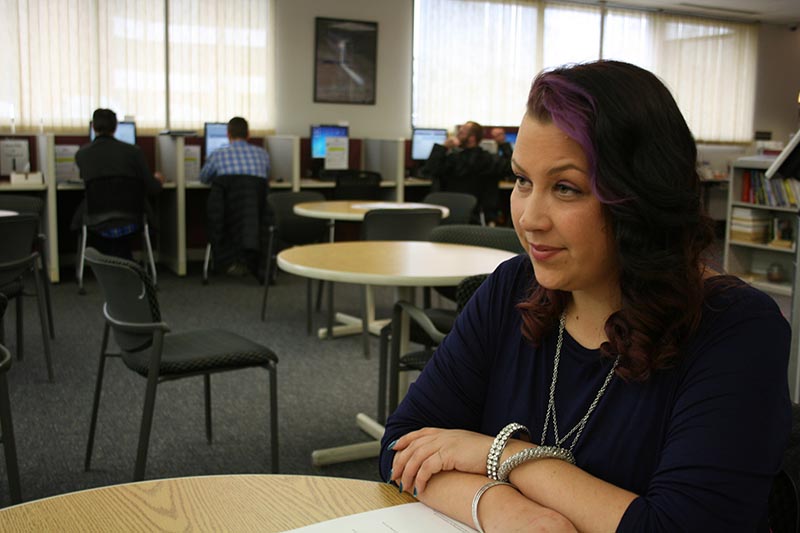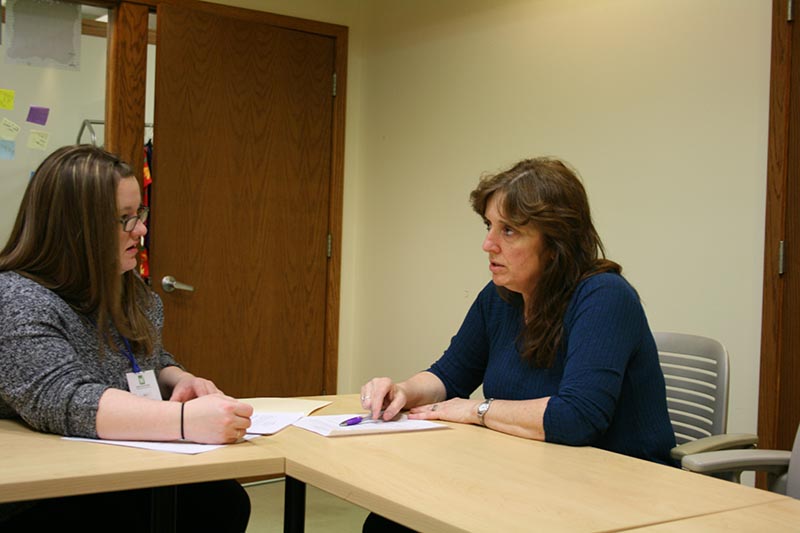In an improving economy, Michigan workers’ part-time blues
A couple weeks after Gov. Rick Snyder issued an upbeat press release about Michigan's falling unemployment rate, Allegan County resident Nicole Jensen wasn't feeling as optimistic.
Snyder's March 8 announcement noted that state unemployment had dipped under 5 percent in January, which showed, the governor said, that “when Michiganders work together to solve difficult challenges, we can have outstanding results.”
Jensen, 31, is not unemployed. But she said her 20-hour-a-week job as a bus driver for a school district south of Holland was just not enough in her household. “It's a real struggle,” she said.
A mother of two children, 13 and 9, Jensen – who said she was in the process of divorce – lives with a boyfriend who recently landed full-time work as a mechanic. But she said their household remains one major expense away from a crisis. She drives a 2002 Honda with nearly 200,000 miles on it, with a transmission she fears is beginning to fail. “It's really paycheck to paycheck,” she said.
On a gray Tuesday morning, Jensen had come to a jobs fair at a Holland Michigan Works! site to buff up her resume and see if she could get a lead on full-time work.
“I'm 31 years old. It's not like we live a life of luxury,” Jensen said. “We don't have cable. I want to have a nice lifestyle, for myself and my children.”
Jensen has plenty of company in Michigan, where approximately 300,000 residents have given up finding work or work part time but want a full-time job.
Michigan's average unemployment rate of 5.4 percent in 2015, the traditional measure of economic health, ranked 29th in the United States. But according to the Bureau of Labor Statistics, 6 percent of Michigan workers in 2015 were looking for full-time work yet stuck in part-time jobs of less than 35 hours a week – 46th in the nation. Only Florida, California, Arizona and Nevada were worse.
To be sure, Michigan's unemployment rate has been steadily falling since the recession, from a peak of 14.9 percent in June 2009 to 7.9 percent in January 2014, 6 percent in January 2015 and down to 4.8 percent in February.
That certainly looks good on paper. But one economic analyst said an improving state and national economy is still leaving many households behind – with the number of underemployed another hallmark of a shrinking middle class in Michigan.
“The unemployment rate really masks a lot of the struggle in Michigan,” said Peter Ruark, senior analyst for the Michigan League for Public Policy, a Lansing-based nonprofit policy organization.
“If you are working 10 hours a week, you are still counted as employed. If you are on the verge of losing your home, you are still counted as employed. It's hard to get in the middle class or stay in the middle class when you don't have full-time employment.”
Ruark said the unemployment rate also cloaks another reality – Michigan's workforce has shrunk considerably since 2000. By his calculation, Michigan had 412,000 fewer workers in 2014 than in 2000. Ruark said these “lost workers” include those who left the state, retired or simply stopped searching for employment.
“Some of them gave up looking,” he said.
Michigan State University economist Charles Ballard attributes the persistence of worker frustration to a lack of fit between worker skill level and employer need.
“I believe part of it is likely to be due to the ongoing mismatch between the jobs that employers want to fill and the skills that some workers have,” he said in an email.
“Those at the bottom of the skill chain, especially high-school dropouts, are at a great disadvantage in today’s economy, and many of them may be the ones who are only able to find a part-time job.”
The Bureau of Labor Statistics officially defines underemployment as the sum of the unemployed, those discouraged from looking and part-time workers looking for full-time jobs. By that definition, underemployment has shrunk in recent years, it's still nearly double its low point of the past two decades. In 2000, it stood at 6.3 percent, before climbing to a peak of 21.5 percent in 2009 as Michigan's economy staggered from the near-collapse of the automobile industry and a steep fall in other manufacturing jobs. Since then it has fallen to 11.4 percent last year.
But the state is far from recovering all the full-time manufacturing jobs shed in the 2000s. According to Michigan's Department of Technology, Management & Budget, Michigan lost nearly 430,000 manufacturing jobs from 1999 to 2009, dropping from about 890,000 jobs in 1999 to 463,100 in 2009. The state now supports about 600,000 such jobs, but that's still a loss of nearly 300,000 such jobs since 1999.
Those losses accelerated a shift toward the service sector, a broad category that encompasses everything from trade and utilities to retail trade, transportation and warehousing, finance and insurance, real estate and accommodations and food services. In 1999, private service jobs accounted for 61.5 percent of employment in Michigan. In 2015, they accounted for 68.5 percent.
At the same time, manufacturing employment fell from 19.4 percent of the work force in 1999 to 13.8 percent in 2015.
Wages, meanwhile, were tumbling.
According to a University of Michigan analysis, the average private sector wage in Michigan in 2001 was $38,532 – more than $1,000 above the national wage of $37,436. By 2012, it had fallen $4,076 below the national private sector wage of $51,541. Adjusted for inflation, private sector wages in Michigan fell by nearly $2,500 for the period, while rising by about $3,000 for all U.S. workers.
The decline in wages hit workers with minimal education particularly hard.
According to analysis by the Michigan League for Public Policy, median hourly wages fell by 32 percent from 1979 to 2013 for those with a high school education, when adjusted for inflation. For those with less than a high school degree, wages fell by a staggering 46 percent during the same period. Workers with some college saw their wages fall by nearly 30 percent.
Even Michigan workers with a college degree during that period saw their wages decline by 4.3 percent after inflation was taken into account.
Only workers with advanced degrees saw a wage increase (10.7 percent). Workers with advanced degrees had median hourly wages of $32.20, compared with $14.65 for those with high school degrees.
And for workers trying to keep things afloat on meager wages and part-time hours, the challenges are considerable.
Kent County resident Laurie Brace, 51, a single mother of one, had been working 40 hours a week for a food service contractor until a couple months ago. She makes just under $10 an hour.
Then, she said, she was cut back to just under 30 hours a week because the firm stated it could not afford the health insurance it was required to offer full-time workers under the Affordable Care Act.
There has been considerable debate over whether the number of Americans working part-time jobs is tied to the act's requirement that employers with 50 or more full-time workers are required to offer health insurance to those working 30 hours or more. A study released earlier this year noted slight shifts to part-time employment in small segments of the work force, but concluded there is “little evidence that the ACA had caused increases in part-time employment as of 2015.”
Either way, Brace realizes she can't meet her household expenses for long unless she finds something better.
“I just got my tax refund of $4,000 back so I'm counting on that for a while.”
When that runs out, she said, “I'll just have to start putting everything on credit cards. There could be some problems.”
In the meantime, she was enrolled in a support program run by a local social service center, North Kent Community Services. It helps single mothers find better employment opportunities, encouraging participants to set personal goals and link with other agencies to find a job or advance their education.
Brace was referred to the Women's Resource Center in Grand Rapids, a nonprofit support organization for women. That led to regular meetings there with a volunteer mentor, who was helping her narrow her goals and craft her search for a better job.
With an associate degree in business management and experience doing payroll and scheduling at a restaurant, Brace is hopeful of landing something in the business field.
While she searches, Brace said she is grateful for the support she's received.
“That really is helpful because you can get really down. It's hard to keep doing it every day when you are not getting anywhere.”
And for some, even a four-year college degree is no guarantee of economic insecurity.
A 2014 study by the Federal Reserve Bank of New York found that more than 40 percent of recent U.S college graduates were working in jobs that did not require a college degree ‒ and of those, nearly 20 percent were working part-time jobs. Six percent were unemployed.
Stephanie Brzezinski, 24, graduated in December from Grand Valley State University with degrees in English literature and journalism.
She's been preoccupied since graduation in a national search for a marketing, editing or communications job. But so far – nothing. In the back of her mind is the reality that she has to begin paying off her $28,000 student loan in June.
Brzezinski moved back to her parents' home in Traverse City after graduation, relieved she can stay rent-free while she searches for work. She has applied as well for full- and part-time jobs in her home town, including at gas stations, grocery stores and retail outlets. She estimates she has put in 200 applications.
At this point, she'd even settle for part-time work as she hopes for something better. That would put her among the officially employed – though not exactly not where Brzezinski intended to be when she graduated.
“Sometimes I think I went to college and I have this degree and it's not really worth anything. It's kind of disappointing,” she said.
“But I try to tell myself, take a lower position, even if it's part-time. Something will come up better down the road.”
Business Watch
Covering the intersection of business and policy, and informing Michigan employers and workers on the long road back from coronavirus.
- About Business Watch
- Subscribe
- Share tips and questions with Bridge Business Editor Paula Gardner
Thanks to our Business Watch sponsors.
Support Bridge's nonprofit civic journalism. Donate today.
See what new members are saying about why they donated to Bridge Michigan:
- “In order for this information to be accurate and unbiased it must be underwritten by its readers, not by special interests.” - Larry S.
- “Not many other media sources report on the topics Bridge does.” - Susan B.
- “Your journalism is outstanding and rare these days.” - Mark S.
If you want to ensure the future of nonpartisan, nonprofit Michigan journalism, please become a member today. You, too, will be asked why you donated and maybe we'll feature your quote next time!


 Part-time worker Nicole Jensen, at a Holland jobs fair: “It's really paycheck to paycheck.” (Photo by Ted Roelofs)
Part-time worker Nicole Jensen, at a Holland jobs fair: “It's really paycheck to paycheck.” (Photo by Ted Roelofs) Economic analyst Peter Ruark: “It's hard to stay in the middle class when you don't have full-time employment.”
Economic analyst Peter Ruark: “It's hard to stay in the middle class when you don't have full-time employment.” Laurie Brace, right, plots job-hunting strategy with volunteer mentor Holly Monahan at the Women's Resource Center in Grand Rapids. (Photo by Ted Roelofs)
Laurie Brace, right, plots job-hunting strategy with volunteer mentor Holly Monahan at the Women's Resource Center in Grand Rapids. (Photo by Ted Roelofs)